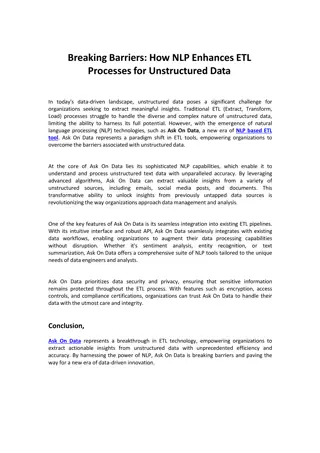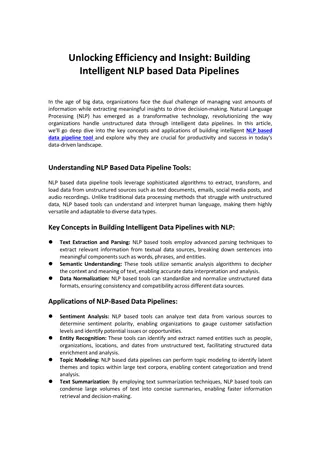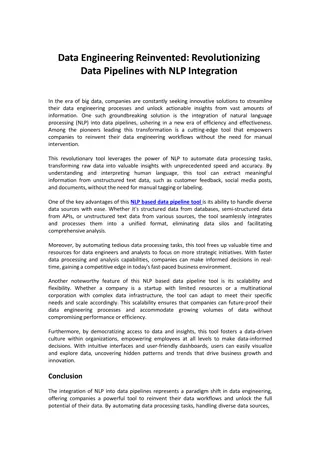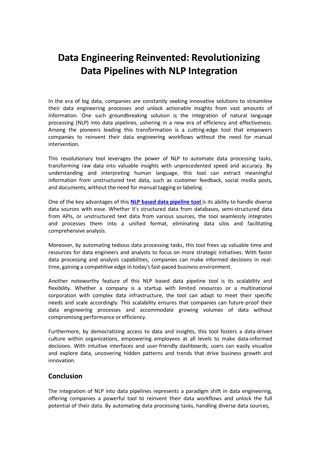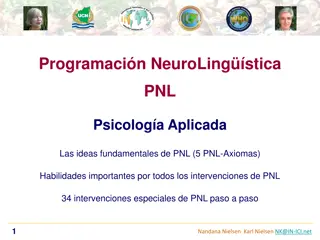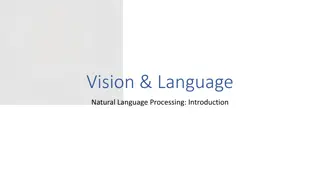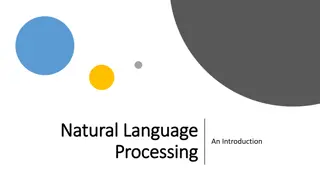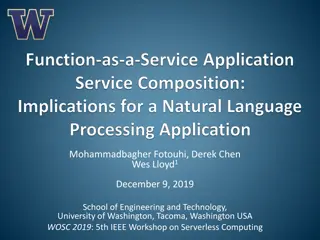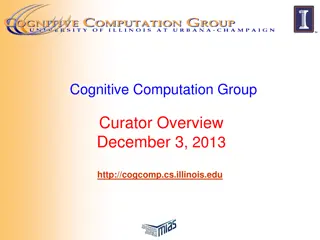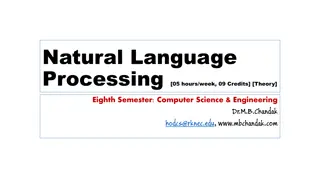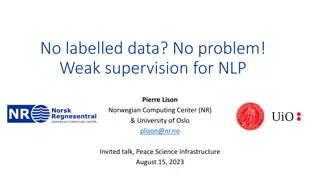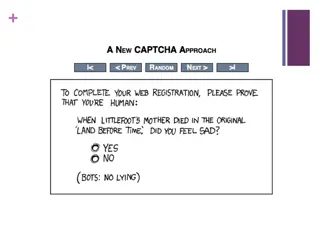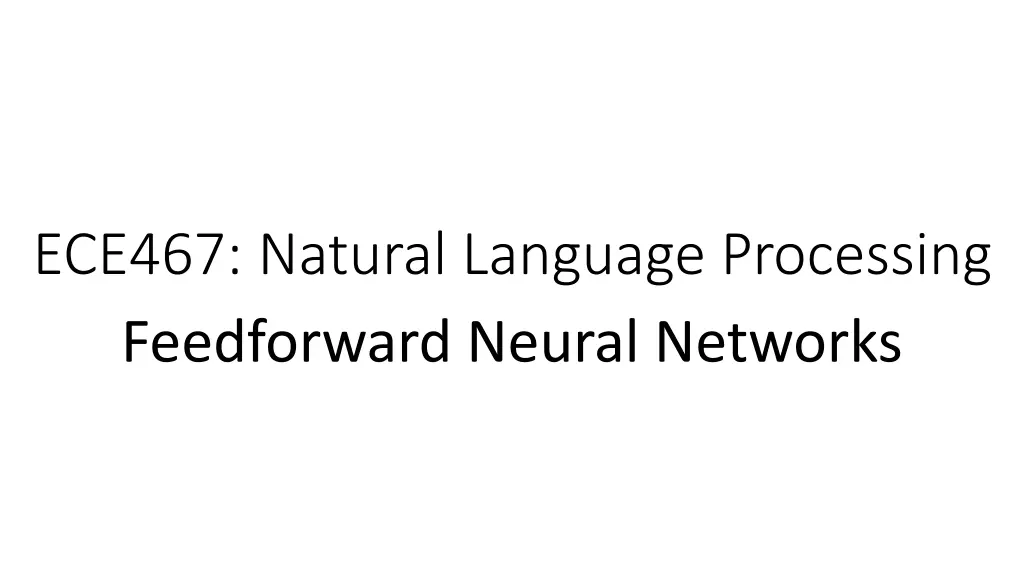
Understanding Neural Networks in Natural Language Processing
Explore the evolution of machine learning approaches in NLP, delve into the origins of neural networks, and gain insights into the structure of a neuron. Discover the transition from traditional methods to the dominance of neural networks in the field of NLP.
Download Presentation

Please find below an Image/Link to download the presentation.
The content on the website is provided AS IS for your information and personal use only. It may not be sold, licensed, or shared on other websites without obtaining consent from the author. If you encounter any issues during the download, it is possible that the publisher has removed the file from their server.
You are allowed to download the files provided on this website for personal or commercial use, subject to the condition that they are used lawfully. All files are the property of their respective owners.
The content on the website is provided AS IS for your information and personal use only. It may not be sold, licensed, or shared on other websites without obtaining consent from the author.
E N D
Presentation Transcript
ECE467: Natural Language Processing Feedforward Neural Networks
Machine Learning Approaches Throughout the history of artificial intelligence (AI) and natural language processing (NLP), there have been many popular machine learning (ML) approaches We covered or mentioned some ML methods during our unit on pre-deep-learning NLP For text categorization, we covered the na ve Bayes, KNN, and Rocchio/TF*IDF approaches It was briefly mentioned that part-of-speech tagging, two popular conventional methods were hidden Markov models (HMMs) and maximum entropy Markov models (MEMMs) Other ML methods that were conventionally used in NLP include decision trees, support vector machines, expectation maximization, etc. Until semi-recently, no single approach dominated; generally speaking, different ML methods seemed to perform the best for different tasks That has changed in more recent years, as neural networks have come to dominate machine learning and NLP
Origins of Neural Networks Neural networks (NNs), a.k.a. artificial neural networks (ANNs), were loosely inspired by the structure of the human brain and its neurons From the current draft of the textbook: "Neural networks are a fundamental computational tool for language processing, and a very old one. They are called neural because their origins lie in the McCulloch-Pitts neuron (McCulloch and Pitts, 1943), a simplified model of the biological neuron as a kind of computing element that could be described in terms of propositional logic. But the modern use in language processing no longer draws on these early biological inspirations." Conventionally, much of the work with NNs focused on feedforward neural networks (this will soon be explained, and it is what we will focus on for this topic) Our coverage of feedforward neural networks is partially based on Sections 7.1 7.5 of the current draft of the textbook; Chapter 7 in general is titled "Neural Networks" The last couple of sections of the chapter focus on neural language models; we will cover that during our next topic I have also partially relied on material from the 3rdand 4theditions of the textbook that I use for my AI course: "Artificial Intelligence: A Modern Approach" by Russell and Norvig (R&N) The next slide shows a rough diagram of a neuron, taken from the R&N textbook (I will discuss it in class)
Computer vs. Brain (from various sources) There are roughly 1011neurons in the human brain There are roughly 1014synapses Both of those estimates vary somewhat from source to source The CPU or GPU in a typical, modern, personal computer has roughly 1010transistors (some have 1011) RAM uses one transistor per bit for DRAM or six transistors per bit for SRAM; therefore, 32 GB of SRAM uses over 1012transistors With modern NNs, we also care about the number of weights (this concept will be explained soon) The number of weights in several large language models is over 100 billion, so on the order of 1011 GPT-4 is rumored to have over 1 trillion weights, so on the order of 1012 The number of transistors in computers had been increasing exponentially for decades according to Moore's law; however, this pace has significantly slowed down in recent years The brain has a much higher degree of parallelism compared to computers, although with GPUs, computers rely on more parallelism than they used to Obviously, signals in a computer are traveling faster than signals in a brain Relative to modern NNs, the human brain relies more heavily on feedback loops
Neural Network Units Neural networks are composed of units (a.k.a. nodes or artificial neurons) Each unit accepts inputs and computes a weighted sum of the inputs; the weights are adjustable parameters of the unit A bias weight is also added (or subtracted, according to some sources) An activation function is applied to the weighted sum, including the bias weight The result of the activation function is the output, or activation, of the unit We will see that the weights, including the bias weights, are learned during the training of a neural network In the original model by McCulloch and Pitts, inspired by neurons of the brain, they used a threshold instead of a bias weight If the sum of the weighted inputs exceeded the threshold, the node would fire This can easily be shown to be equivalent to using a (subtracted) bias weight and a simple threshold activation function (we will discuss activation functions soon) The figure on the next slide shows a diagram of a neural network unit The equations on the following slide define how the unit behaves, assuming a sigmoid activation function; activation functions, in general, will be discussed on later slides
Activation Functions The activation function introduces a non-linearity, which is necessary for a neural network to represent functions that are not linearly separable We will see later that neural networks also must contain hidden layers to represent functions that are not linearly separable In conventional neural networks, two popular activation functions were the threshold function and the sigmoid function The sigmoid function is also known as the logistic function, and another common use of it is related to logistic regression The figure on the next slide, taken from the 3rdedition of the R&N textbook, shows graphs explaining these conventional activation functions Threshold activation functions are not common in deep neural networks (which we will discuss later in this topic as well as future topics) Sigmoid activation functions are still somewhat common in certain situations; another graph of a sigmoid function (from our textbook) is shown two slides from now
Conventional Activation Functions (R&N, Ed. 3) Threshold Function Sigmoid Function
Other Modern Activation Functions Other common activation functions in deep neural networks include the tanh function and rectified linear units (ReLUs) Formulas for these activation functions are: Graphs of these activation functions are shown on the next slide As mentioned earlier, sigmoid activation functions are also still somewhat common in deep neural networks, at least in certain circumstances Textbook: "These activation functions have different properties that make them useful for different language applications or network architectures"
AND, OR, and NOT Part (a) of the figure above (from our textbook) shows an AND node; part (b) shows an OR node This assumes a threshold activation function; the book doesn t call it that, but it shows the formula for it (note that the node does not fire at exactly 0): Some points I would like to add: If we modify the bias weights in (a) and (b) to -1.5 and -0.5, respectively, then it is not relevant what happens when the weighted sum is exactly 0 It is also easy to create a node that functions as a NOT gate; e.g., we can create a node with a single input weighted by -1 and a bias weight of 0.5 Since we can compute AND, OR, and NOT with individual nodes, then with a network of nodes, we can compute any Boolean function
Perceptrons The nodes we have seen so far are examples of perceptrons, a.k.a. single-layer perceptrons Perceptrons can be defined as NNs which output binary values and do not contain any hidden layers (to be discussed soon), although the exact definition differs from source to source Perceptrons are generally allowed to contain multiple nodes that share the same inputs, but each node functions completely independently of the other So, perceptrons are only capable of representing functions that can be represented by individual nodes Although individual nodes (and more generally, perceptrons) can represent AND, OR, NOT, and many other functions, they are severely limited In a very influential 1969 publication, Minsky and Papert proved that single units cannot compute XOR More generally, perceptrons can only represent linearly separablefunctions It can easily be shown that a perceptron with a threshold activation function will fire if and only if w x > -b (the left-hand side represents a dot product of the inputs and the weights) Positive and negative examples of linearly separable functions can be separated by hyperplanes in the input space The figure on the next slide (from our textbook) demonstrates that hyperplanes can separate true and false instances of AND and OR, but no hyperplane separates true and false instances of XOR
Feedforward Neural Networks One way to represent functions that are not linearly separable is by using feedforward neural networks; a.k.a. feedforward networks or sometimes multi-layer perceptrons Some sources hyphenate feed-forward or write it as two separate words A feedforward neural network is typically organized into layers The output nodes (the only type in perceptrons, unless you count the inputs) constitute an output layer Sources differ as to whether the inputs count as nodes or constitute a layer Our textbook does refer to the inputs as an input layer, but they don t include it when counting layers In addition to the input layer and the output layer, there are one or more hidden layers, consisting of hidden units (a.k.a. hidden nodes) When the nodes in one layer connect with every node from the previous layer, the later layer is said to be fully-connected Typically, the inputs to a feedforward neural network do not have an activation function applied to them directly; the inputs are fed as scalars to the nodes in the first hidden layer The next slide shows an example of a feedforward neural network with one hidden layer Our textbook calls this a two-layer network, but some sources would consider it to be a three-layer network
Computing Values for the Hidden Layer Note that the fixed input (in this case, +1) is connected to every node in the hidden layer, and each has its own bias weight You could apply the equations we looked at before separately to each hidden node; alternatively, you can handle them all at once We can think of the inputs as a vector, x, and the bias weights as a bias vector, b We can think of the other weights between inputs and hidden nodes as a matrix, W If the hidden nodes use a sigmoid activation function, their outputs can be computed as: h = (Wx+b) Note that Wx+b is a vector, and the activation is being applied element-wise Note: You need to be careful with how you treat rows and columns of the matrix if you are implementing a neural network using vectors and matrices Some sources treat the vectors as column vectors, some as row vectors; some use transposes for vectors or matrices Conventionally, nodes were often handled one at a time, but there is a significant computational advantage of representing layers as vectors and representing weights between layers as matrices Modern deep learning libraries, such as TensorFlow and PyTorch, take advantage of this by parallelizing computation with GPUs
Computing Values for the Output Layer In many neural network architectures, the output nodes will also include bias weights connected to fixed inputs; in our first sample neural network (shown two slides ago), they do not We can represent the intermediate output as z = Uh, where h = (Wx+b) as explained on the previous slide We could apply a sigmoid function to z, as we did for the hidden layer, and for some tasks, this might make sense (in particular, if the output nodes represent binary, or independent, categories) Another common type of output layer for modern neural networks is the softmax layer The softmax layer converts a vector of real numbers into a vector of floating-point values between 0 and 1 that add up to 1 (which is appropriate when the output nodes represent mutually exclusive and exhaustive categories); the formula is: The output of the softmax function is often interpreted as a probability distribution In summary, the formulas used to calculate the values produced by the sample feedforward neural network would be:
Deep Feedforward Neural Networks If a feedforward neural network has more than one hidden layer, it would generally be considered a deep neural network Consider a neural network with n layers, not including the inputs, numbered from 1 to n Let the ith layer have incoming weight matrix W[i], bias vector b[i], activation function g[i], and output a[i]; also let a[0] be the input vector Then we can implement forward propagation (the textbook calls this the forward step) as follows: This pseudo-code allows a different activation function, g[i], to be used at each layer; 'g' is commonly used to represent a general activation function
Creating a Neural Network The textbook never really discusses how you might go about creating a neural network for a task you are working on Creating a neural network for a particular task involves: Choosing an architecture (e.g., the number, types, and sizes of layers); we will learn about various types of neural network architectures in future topics Setting hyperparameters(we haven t talked about these yet) Obtaining a training set (including examples with known inputs and outputs) Training the neural network to learn the adjustable parameters of the network (i.e., the weights, including the bias weights); we will talk more about training shortly The architecture and hyperparameters are set manually, before training; optionally, they can be tuned based on a development set, a.k.a. validation set or tuning set After the neural network has been finalized (including tuning and training), you can evaluate it using a test set
Loss Functions A loss function measures how far the predicted output of a neural network is from the true output One common loss function when training neural networks for which the output layer is a softmax layer is the cross-entropy loss function The textbook discusses the cross-entropy loss function in Section 5.5; Chapter 5 more generally covers logistic regression, which we will not cover in this course The formulas below are from an earlier draft of the textbook (in the current draft, they are less general) If the true output is a probability distribution, ?, across a set of categories, and the system predicts the output distribution ?, we can use: If there is only one correct output category, this simplifies to: If the output layer is a softmax layer, we can express this as:
Training Neural Networks Before training a neural network, it is conventional to initialize all the weights to small random values (I'll talk about this a bit more in class) In principle, gradient descent could be used to train the weights of a neural network In theory, this means that the loss function would be computed based on the entire training set Next, the partial derivative of the loss w.r.t. each weight in the network would be computed Then, each weight would be pushed in a direction to reduce the loss In practice, stochastic gradient descent (SGD) is used instead One mini-batch is used at a time to estimate the gradient; each mini-batch is a set of training examples The size of the mini-batch is a hyperparameter of the neural network; it could be a single training example or some larger set of training examples Weights are adjusted for each mini-batch as opposed to the entire training set at once (we'll discuss the procedure for adjusting weights in more detail on the next slide) It is common to loop through the entire training set multiple times, one mini-batch at a time; each pass through the training set is called an epoch Modern implementations use vectors and matrix calculations to implement the procedure, making SGD more efficient due to parallelization
Adjusting Weights Deriving the formulas to update weights going into the output nodes is relatively simple, since each weight affects one output node Deriving the formulas to update weights into hidden layers is more complicated The procedure to do this involves backpropagation, a.k.a. error backpropagation or backprop, to compute the partial derivative of the loss function w.r.t. each weight into hidden layers We will only briefly discuss backpropagation for feedforward neural networks in this course However, we will examine backpropagation in greater detail for recurrent neural networks when we cover that topic Once the gradients for all weights are calculated, they are multiplied by a learning rate that controls the size of the adjustments Modern neural networks have adaptive learning rates Overfitting can affect all methods of ML, and it is of particular concern with deep learning due to the large number of adjustable parameters (I will talk more about the concept of overfitting in class) There are methods of regularization that can help to mitigate overfitting; for example: An extra term is often added to the loss function to penalize large weights Dropout randomly drops units or weights during training
Computation Graphs Neural networks can be described using computation graphs These are graphical representations of processes for computing mathematical expressions A graph representing a forward pass shows how to compute values An example graph representing a forward pass for a specific formula (not a neural network) is shown on the next slide A graph representing a backward pass shows how to compute partial derivatives of the output with respect to each node An example graph representing a backward pass for the same specific formula is shown two slides from now The computation of the gradients during the backward pass is called backward differentiation Note that backward differentiation makes repeated use of the chain rule for differentiation We will also see that neural networks can be represented as computation graphs; those graphs tend to look more complex Representing neural networks as computation graphs has become more common in recent years (we'll discuss this more soon)
Representing NNs as Computation Graphs The figure on the next slide (Fig. 7.15 in the current draft) shows a simple feedforward neural network represented as a computation graph The neural network has two input nodes, one hidden layer with two ReLU nodes, and one output sigmoid node The nodes shown in light blue represent the regular weights and bias weights These are the adjustable parameters of the neural network that are updated during training When a computation graph represents a neural network, backpropagation is equivalent to backward differentiation Some modern deep learning libraries (e.g., TensorFlow and PyTorch) represent neural networks as computation graphs When you build a neural network out of standard types of layers, and you use a standard loss function, backward differentiation can be applied automatically You can also define your own types of layers and loss functions, as long as you specify how derivation works for them
Neural Networks in NLP (very briefly) In the pre-deep-learning days of NLP, the most common type of NN used in NLP was a feedforward NN with a single hidden layer There was typically an input node for every distinct word in the vocabular, and the value of the input was typically a word weight Therefore, for applications such as text categorization, you could think of the input layer as a TF*IDF document vector The number of weights between the input layer and the hidden layer was considered large compared to most conventional ML methods used in NLP This often led to overfitting (we talked about this concept earlier) We will see that since the start of the first deep-learning revolution in NLP, word embeddings became popular for use as inputs to neural networks We will learn about static word embeddings, such as those produced by word2vec, in our next topic In recurrent neural networks, such as LSTMs, it was common to use one word embedding as input at a time Transformers, on the other hand, accept embeddings for a fixed-sized span of text at a time We will learn about these types of architectures later in the course Modern NLP systems rely on contextual word embeddings as opposed to static word embeddings Modern NLP systems also typically tokenize into subwords, which are mapped to subword embeddings (e.g., we learned about byte-pair encoding earlier in the course)

